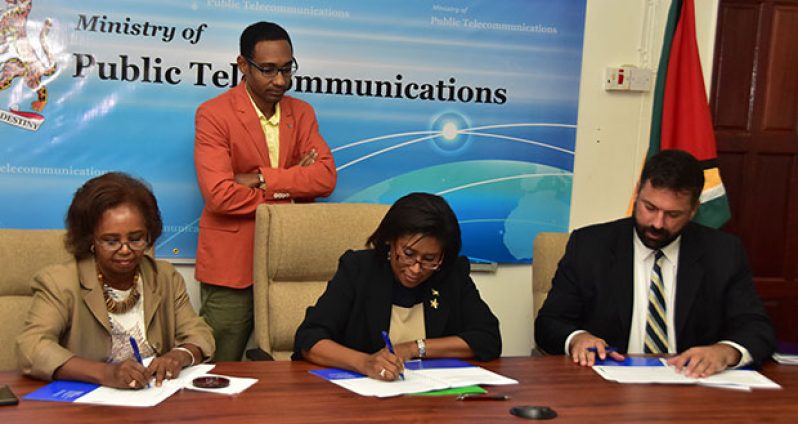By Ravin Singh
HINTERLAND, remote and poor communities are poised to benefit significantly from Information and Communication Technology (ICT) development with the signing of a contract on Friday for a needs assessment project which will commence immediately.Valued at Gy$104M, the contract was signed between the Government of Guyana, represented by Minister of Public Telecommunications, Cathy Hughes; the United Nations Development Programme (UNDP), represented by Country Representative Khadija Musa; and Germany-based company Detecon Consultancy, represented by Stephan Dieter.
Titled “ICT Access and e-Services for Hinterland, Poor and Remote Communities”, the project is a starting-point ICT study to find out, among other things, what infrastructure, technical capacity and legal framework are already there in poor, remote and unserved areas in Guyana.
Deputy Head of the E-Government Agency at the Ministry of Public Telecommunications, Francis Simmons, said the first objective of the project is to conduct a baseline and feasibility study, to inform development of the full project document. He explained that, under this objective, the necessary baseline data and information will be compiled, and indicators will be established against which the project and its impacts will be measured.
Subsequently, a needs assessment and feasibility study will be done on infrastructure, content and energy sustainability of the project.
Simmons explained that these activities are geared towards providing the best solutions in providing ICT access and services for the hinterland, poor and remote communities, as well as assessing the overall viability of the project.
The second objective, he said, is to develop full ICT access and e-services for the Hinterland, Poor and Remote Communities’ project. He noted that, under this objective, the final project will be developed and finalized, based in great part on the information and conclusions of this baseline needs assessment and feasibility study.
The project will be implemented under the National Implementation Modality, and will be funded under the Guyana REDD+ Investment Fund (GRIFF), once approved by the GRIFF+ Steering Committee.
It was further noted that the implementing entity of the project will be the E-government agency of the Ministry of Public Telecommunications, which will also be responsible for the actual execution of project activities within the project scope and constraints.
UNDP will be the partner entity to the project under the GRIFF+ framework, and will be responsible for quality assurance and for providing and incorporating social, judiciary and environmental safeguards and best practices into the design and implementation of the project. The UNDP will also be responsible for the supervision of the project’s adherence to the criteria.
Engaging the media just prior to the official signing of the contract, UNDP Representative Khadija Musa stated that the project focuses on connecting the coastland with the hinterland through ITC, in order to expand economic development.
She revealed that UNDP conducted a competitive international bidding process, and received 14 expressions of interest from prospective bidders who participated in an online pre-bid conference, where they were allowed to ask questions regarding the project. Of the 14 bidders, four firms submitted proposals.
Minister Hughes pointed out that, for many years, Guyana has been lagging behind the rest of the world because of the lack of technological resources to meet the demands and standards in almost every field of endeavour, for every service and product.
She underscored the need for the assessment project, which she reasoned would allow Government to start an evaluation of the country’s ICT needs.
“Most of us know that, for many years, what happens on the coast and what happens in the hinterland regions vary vastly; and, in fact, when we look at sectors such as education (and) commerce development, our hinterland and remote communities have really not been able to stay on par,” Minister Hughes said.
She referred to a recent visit to Surama, where she had the opportunity to purchase “one of the most beautiful indigenous hammocks” made by a group of women there, and explained that the woman who crafted that hammock is dependent on the few people who travel to Surama to support her business.
However, she noted that with the introduction of access to technology, there is much more that can be done to support business-oriented activities which will lift the standards of living for persons in those remote communities.
She suggested that the woman who made the hammock will be afforded the opportunity to create her own website; and with facilities such as international shipping services and persons being able to pay online, the world becomes her market.
Further, Minister Hughes explained that the programme will provide for the installation of ICT infrastructure and networks for Internet and telephony access for hinterland, poor, and remote communities. Training will also be provided, not only for residents in those communities, but also for Government staff and entities such as the E-Government Unit.
“When this Government took over the reins of statehood last year, one of the first promises President (David) Granger made was to ensure that our technologies would be brought up to par with the rest of the world…to use a well-known cliché, bring Guyana into the 21st Century; and this project puts Guyana firmly on the road to achieving that objective,” the Public Telecommunications Minister said.
Implementation of the ICT ‘Access and e-Services for Hinterland, Poor and Remote Communities’ project will result in installation of ICT infrastructure and networks for Internet, and telephony access for hinterland, poor and remote communities; provision of secondary equipment to hinterland, poor and remote communities for deployment of e-Services, e-government services, and to access information and other benefits; training on the installation, use and maintenance of ICT infrastructure and networks to be utilized on the project; training of hinterland, poor and remote community members for increased ICT literacy; provision of e-Services, including emphasis on e-learning, a national ICT action plan, and institutional capacity development for the Government of Guyana.




.png)









